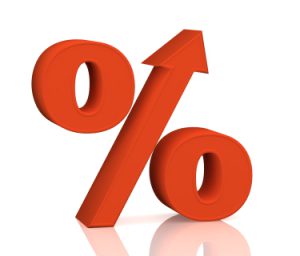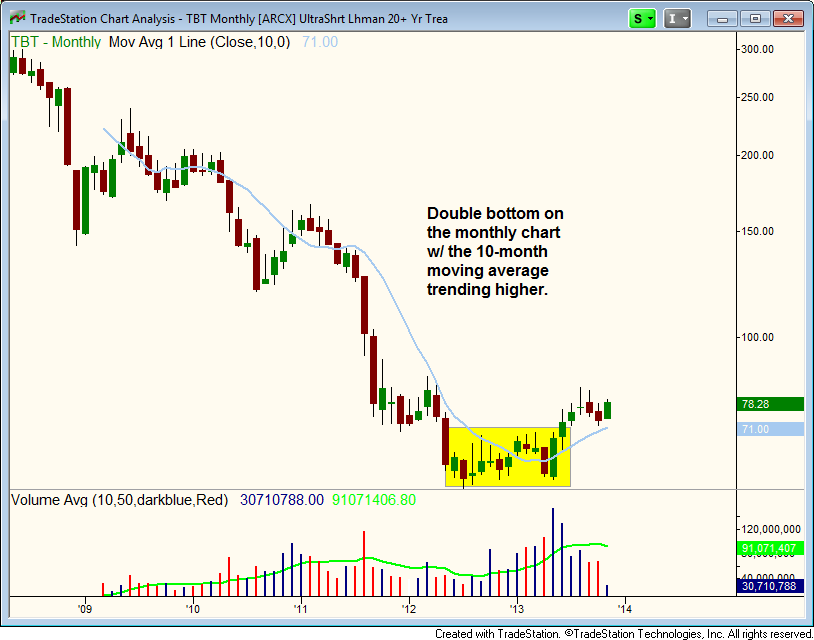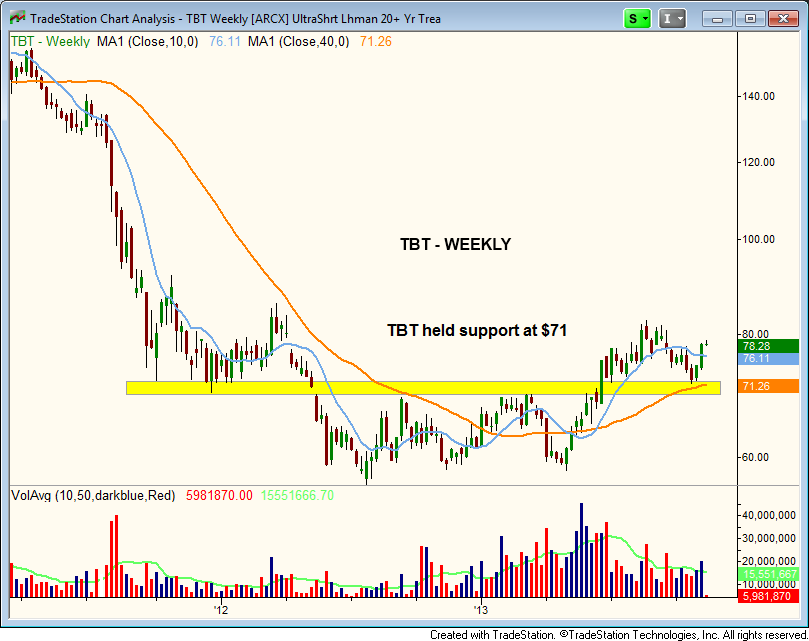 Since our market timing model shifted out of “Buy” mode on November 7, we have been focused on trading ETFs with a low correlation to the direction of the stock market, rather than individual leading stocks.
Since our market timing model shifted out of “Buy” mode on November 7, we have been focused on trading ETFs with a low correlation to the direction of the stock market, rather than individual leading stocks.
On November 11, we detailed 2 potential ETF trade setups with low to no correlation to overall stock market direction: ProShares UltraShort Yen – $YCS (a currency ETF) and Physical Palladium Shares – $PALL (a commodity ETF).
Today, we enter the world of fixed-income (bond) ETFs with a potential intermediate-term trade setup into ProShares UltraShort 20+ Year T-bond ($TBT).
Higher Interest Rates = Lower Bond Prices = A Tradeable Inverse Bond ETF
$TBT is a leveraged, inversely correlated ETF designed to move in the opposite direction (and double the percentage) of iShares 20+Year T-bond ($TLT).
As interest rates rise, the corresponding prices of the bonds decline (and vice versa).
If $TBT (which moves in the opposite direction of long-term bond prices) is poised to head higher, it means long bond prices are primed to move lower.
In turn, this means long-term interest rates may soon be headed higher.
Long-Term Bottoms
Have long-term interest rates bottomed out? The “big picture” monthly and weekly charts of $TBT below suggest so.
Starting with the monthly chart, the double bottom pattern and subsequent, big-volume rally in May and June are two valid technical signs that a significant bottom has formed:

Additionally, the 10-month moving average is also now sloping higher, and $TBT has been forming a bullish, tight-ranged consolidation over the past few months.
Drilling down to the shorter-term weekly chart pattern of $TBT, notice the major band of horizontal price support around the $71 area (highlighted in yellow).
The 40-week moving average (roughly same as 200-day moving average) also converges near that same area of price support.
The 10-week moving average (blue line) is well above the 40-week moving average (orange line), which is now above resistance of the prior highs from January through March of this year.
However, the 10-week moving average has recently turned lower, which suggests $TBT may need a few more weeks of sideways consolidation before resuming its uptrend:

Patience Over Action
Most important to note about this potential ETF trade setup is that $TBT is not actionable right now.
Nevertheless, now is the time to be building a new “watchlist” of select ETF trades to consider buying (or selling short) while our market bias hangs back in neutral mode.
In weakening or indecisive markets, the most profitable swing traders sit around and wait (in cash) for the great trade entries to literally fall into their laps, rather than chase them with reckless abandon.
UPDATE: November 19 at 2:00 pm ET
In the six days since this article was posted, $TBT has generally ben in pullback mode.
Yesterday (November 18), $TBT undercut near-term support of it 20-day exponential moving average, but is presently snapping back above yesterday’s intraday high, which presents traders with a potential low-risk buy entry for short to intermediate-term trade entry.
Since the $74 level appears to be holding, $TBT will print its first higher swing low within the current 14-week consolidation.
If $TBT meets our technical criteria for buy entry in the coming days, we will report our preset, exact buy trigger, stop, and target prices to subscribers of our ETF and stock picking newsletter.
Which other ETFs with a low correlation to stock market direction are on your watchlist right now? What do you like about the setups? Let us know by dropping a comment below.
